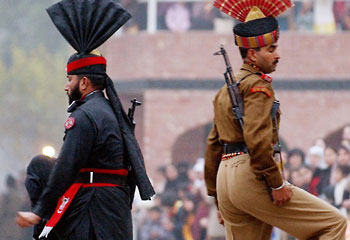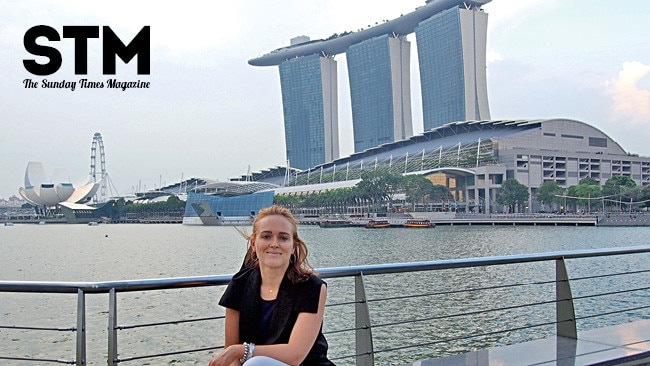Best of enemies
MICHAEL Gebicki witnesses a surprising daily ceremony at Wagah on the border between India and Pakistan.

INDIA and Pakistan usually view one another over the barrel of a gun, and that mutual animosity is crystallised in a ceremony that takes place daily at Wagah, just outside the northern Indian city of Amritsar and the only crossing point along the more than 3000km of that shared frontier.
The event is known as Beating Retreat, the nightly closing of the gates between the two countries and lowering of their respective flags. This mundane ritual is elevated to an exhibition of nationalism that is seldom seen off the cricket pitch.
The bus from Amritsar leaves us at a gate set into a high, fortified wall that we detour around, shuffling in a crowd of turbaned Sikhs along a path that makes a rambling semicircle into wheat fields before returning to a kind of amphitheatre. To our left is India and tiers of concrete stands that hold 8000 spectators. They are filling fast. To our right is the gate that marks the border and on the other side is Pakistan, and a similar arrangement of stands with perhaps 2000 Pakistanis. On the Pakistan side, the men and women are separated.
Keeping a watchful eye over the crowd are several troopers of India's 180,000-strong Border Security Force, and they're all lofty. The BSF soldiers at Wagah are chosen for their height. Not one of them appears to stand less than 188cm in his white gaiters. In the peculiar game of one-upmanship played out daily at Wagah, height matters. Underlining their stature, the soldiers sport what looks like a cock's comb, a pleated, fan-shaped headpiece in red and gold.
The atmosphere is taut with patriotic fervour. A group of 50 youths marches along the roadway that crosses the border under a banner that proclaims World Social Forum. Then a master of ceremonies appears, tall and with a moustache, who begins working the crowd with the chant, "Hindustan zindabad" (India forever) while the Pakistanis echo with their own refrain. Excitement ripples through the stands and the guards struggle to maintain control.
A skinny youth in a black shirt waves a big Indian flag in front of the crowd, then runs towards the gate and waves it tauntingly at the Pakistanis. A couple of girls grab the flag and do the same. Now the flag passes to a man with one leg and a crutch who storms toward the gate, waving the banner furiously. The crowd goes wild.
The master of ceremonies calls for calm and a squad of BSF troopers emerges from the guard house. Two soldiers, wearing white gloves and carrying swagger sticks (officers, presumably), begin marching towards the gate in double time, followed by the remainder of the squad. That word, marching, requires some explanation. This is more like a charge: four men in tight formation doing a full-throttle goose-step, legs pumping, arms swinging like pendulums gone mad, advancing towards the gate with a scowl of pure, unblinking hatred fixed on their faces. Meanwhile, the Pakistani Rangers are doing the same thing on their side At the gate they meet.
An Indian officer appears to shake hands with his Pakistani counterpart, while behind them there's a great deal of theatrical stamping. Imagine a man trying to kick a ball that is suspended above his head, then slamming his foot down as hard as he can, and doing all of this in unison with his opposite number.
There's also considerable shouting, grimacing and virtual headbutting as the two sides face off at close quarters, as well as a lusty display for which I can think of no military phrase other than "spitting at theenemy". The crowd is loving this but what we are seeing is thrillingly dangerous: two nuclear-armed countries with vast armies and a deep and implacable loathing for one another, divided by history and spurred on by religious fanatics. Yet at the one point where they intersect, the animosity is distilled and cloaked by ritual.
Something complicated is happening with ropes at the far end. The flags are being lowered in unison. Despite the antagonism, there is a high degree of co-ordination in the macrame that goes on between the two sides. Eventually the flags come down with a flourish, are folded and the gates swing shut.
The soldiers march back, there are more high kicks in front of the regimental emblem and a voice over the loudspeaker announces the Hindi equivalent of "Show's over".
The stands are abandoned as the crowd streams away. Their mood is buoyant, like football supporters whose team has just won a match. Teenagers are skylarking and showing off, adults are jostling to be photographed with soldiers and tourists. Which just goes to show that a boisterous display of naked aggression is wonderfully uplifting for the spirits.
Michael Gebicki was a guest of Singapore Airlines and Adventure World.



